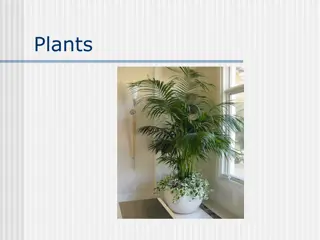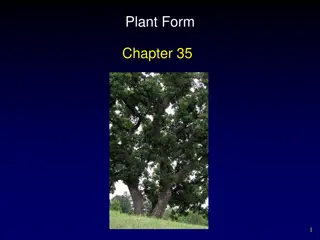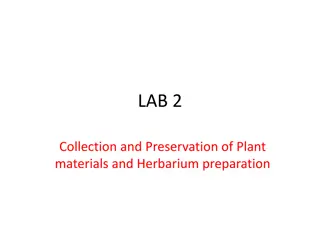Overview of Hutchinson and Takhtajan's Plant Classification System
Hutchinson and Takhtajan, as presented by Dr. R. P. Patil, Professor & Head of the Department of Botany at Deogiri College, Aurangabad, have contributed significantly to the field of plant classification. John Hutchinson, a renowned British botanist, introduced a classification system based on principles influenced by Bessey. This phylogenetic system emphasizes the evolutionary aspect of plant characteristics. The principles range from the arrangement of floral parts to the nature of flowers and vascular bundles. Hutchinson's classification system reflects a comprehensive understanding of plant evolution, morphology, and diversity.
Download Presentation

Please find below an Image/Link to download the presentation.
The content on the website is provided AS IS for your information and personal use only. It may not be sold, licensed, or shared on other websites without obtaining consent from the author. Download presentation by click this link. If you encounter any issues during the download, it is possible that the publisher has removed the file from their server.
E N D
Presentation Transcript
Hutchinson and Takhtajan Presented by Dr. R. P. Patil Professor & Head Department of Botany Deogiri College, Aurangabad
John Hutchinson 1884-1972 John Hutchinson, a British botanist and formerly the office holder of museum of royal botanical garden, kew, England has given the classification of plants based on the principles followed by Bessey his classification was published in his famous book families of flowering plants in two volumes. Volume-II published in 1926 dealing with dicotyledonsand volume-II published in 1934 on monocotyledons.
The system of classification was revised in British flowering plants (1948) and again the second edition of the families of flowering plants (1959) It is underlying principles are more like the besseeyan syatem than the englerian system.
This is phyogenetic system is based on the assumption that: i) Plants with petals and sepals associated with other floral and anatomical character are primitive and more ancient than the plants without sepals. ii) Free floral parts are more primitive than the agnate or connate parts. iii) Spiral arrangement of floral parts sepals petals and stamens are more primitive than cyclic arrangement. iv) Hermaphrodite condition and free stamens are primitive over the unisexual flowers and connate stamens. v) A regular or actinomerphic flower is primitive with zygomorphic flowers. vi) Solitary flower is more primitive than the inflorescenced flowers. vii) Hypogyny is more primitive than epigynyand perigyny conditions. viii) A flower with indefinite number of floral parts is primitive over few numbers of floral parts. ix) Complete flower are primitive than incomplete flowers.
Principles of Hutchinons Classification: 1. The evolution is both upward and downward, the former tending towards preservation and the later to their reduction and degeneration of characters. 2. Evolution does not necessarily involve call organs at one time or simultaneously. 3. Aquatic plants are derived from terrestrial and saprophytes parasites epiphytes are more recent. 4. Trees and shrubs are more primitive than herbs. 5. Perennials are more primitive than biennials and annuals. 6. Plants with vascular bundles arranged in a ring are more primitive those in which vascular bundlers are scattered. 7. Spiral phyllotaxy is primitive than whorled and opposite phyllotaxy. 8. Dioecious plants are more advanced than bisexual flowers. 9. Unisexual flower are more primitive than bisexual flowers. 10. Petalod flowers are more primitive than bisexual flowers. 11. Gamopetally is more advanced than polypetalae. 12. Zygomorphic flower are more advanced than actinomorphic flowers.
13. Hypogyny is more primitive than perigynyand epigyny. 14. Simple leaves are more primitive than compound leaves. 15. Solitary flower is more primitive than infloresceneed flowers. 16. Spirally imbricate floral parts are more primitive than whorled and valvatearrangement. 17. Apocarpy is more primitive than syncarpy. 18. Polycarpy preceedes oligocarpy. 19. Endospermic seeds with small embryo are more primitive than non endospermic seeds with large embryo. 20. Flowers with numerous stamens are more primitive than those with fewer stamens. 21. Free stamens precede the fused ones. 22. Aggregate fruits are more evolved than single fruit and capsule preceedes berry or drupe. 23. Parietal placentation is more primitive than axial and free central placentation. 24. Trees or arboreal habit are more primitive than climbers are twiners in any one family or genus.
Plants A) Sub-phylum I Dicotyledonae i) Embryo with two cotyledons ii) Tap root system iii) Reticulate veination of leaves iv) Pentamerous floral parts This sub phylum further divided into two divisions. Division (I) : Lignosae i) Trees and shrubs, woody plants. ii) It includes 54 orders which begins with magnolialesand ends with verbenales. Order 1 Magoliales (Magnoniaceae) Order 2 Anonales (Annonaceae) Order 6 Rosales (Rosaeae) Order 7 Leguminales (Mimosae, Fabaceae) Order 30 Cucurbitales (Cucubitaceae) Order 33 Maivales (Malvaceae) Order 52 Rubiales (Rubiaceae) Order 54 Verbenales (Verbenaceae)
Division II Herbaceae: i) It includes all herbaceous plants. ii) Plants may be annuals or binnials or perennials. iii) This division includes 28 orders which start with ranales and ends with lamiales. Order 55 Ranales (Rannunculaceae, Nymphaceae) Order 59 Rhoedales (Papaveraceae) Order 60 Cruciales (Pareitales ) - Cruciferae Order 72 Umbellales Umbelliferal (Apiaceae) Order 76 Asterales Compositae (Asteraceae) Order 77 Solanales (Solanaceae, convolvulaceae) Order 78 Personales (Acanthaceae, Scorephulariaceae) Order 82 Lamiales (Labiatae)
SUB PHYLUM 2- Monocoty ledonae: i) Embryo with one cotyledon ii) Fibrous adventitious root system iii) Parallel veinationof leaves iv) Closed and scattered vasular bundles v) Trimerous flowers This sub phylum divided into three divisions Division I Calyciferae: i) Flowers with distinct calyx and corolla ii) Sepals green in colour, petals colured variously. iii) It includes 12 orders, starting with butamalesand ends with zingiberales. Order 1 Butamales (Butamaceae) Order 8 Commelinales (Commelinaceae) Order 12 Zingiberales (Zingiberaceae; musaceae)
Division II Corolliferae: i) Both calyx and corolla are not distinct in colourantion. ii) Sepals may be coloured other than green. iii) Petlas and sepals present in different whorl. It includes 14 orders begins with liliales and end with orchidales Order 13 Liliales Liliaceae Order 15 Aeales Araceae Order 17 Amaryllidales Amaryllidaceae Order 21 Palmales - palmales palmae (Arecaceae) Order 26 Orchidales Orchidaceae Division III Glumiflorae i) Flower with reduced perianth ii) Neither sepal not petal is distince and reduced to membanous lodicules. This includes 3 orders and six familes Order 27 Juncales Juncaceae Order 28 Cyperales Cyperaceae Order 29 Graminales Graminae (Poaceae)
Merits of Hutchinsons Classification: i) It is most phylogeneticsystem of classification based on natural characteristic of plants. ii) This system is based on evolutionary tendencies and interrelationship among angiospermic plants. iii) Magnoliales representing arborescent plants and ranales representing herbaceaous plants which shows parallel evolution. iv) Several big orders have been broken into small orders like rosales, paritales, malveles, leguminalesetc. v) Many families have been raised to the rank of orders, leguminosae famile raised to order leguminales. vi) Reshuffiling or genera and families vii) Origin of monocots from dicots and placement of first dicotand then monocot families is correct in all respect. viii) Placing of gymnosperms before angiosperms in flowering plants.
Armen Leonovich Takhtajan June 10, 1910 November 13, 2009 Takhtajan worked at the Komarov Botanical Institute in Leningrad, where he developed his 1940 classification scheme for flowering plants, which emphasized phylogenetic relationships between plants. The "Takhtajan system" of flowering plant classification treats flowering plants as a division (phylum), Magnoliophyta, with two classes, Magnoliopsida (dicots) and Liliopsida (monocots). These two classes are subdivided into subclasses, and then superorders, orders, and families. The Takhtajan system is similar to the Cronquist system, but with somewhat greater complexity at the higher levels. He favors smaller orders and families, to allow character and evolutionary relationships to be more easily grasped. The Takhtajan classification system remains influential; it is used, for example, by the Montr al Botanical Garden.
Principles 67 Principles Woody Precede to Herbs Evergreen to Decidous Simple pinnately nerved to Pinnatified Pinnate venation to Palmate Reticulate venation to Parallel Simple lvs to Compound Alternate to opp & verti Scalariform to simple pits in vessels Monocolpate to tricolpate to triporate Simple to sculptures Bitegmic to unitegmic Anatropous to other types Many seeded fruits primitive
"Diversity and Classification of Flowering Plants" (1997), Classification (`Takhtajan system') based on the most recent studies in plant morphology, embryology, phytochemistry, cytology, molecular biology and palynology. Flowering plants are divided into two classes: class Magnoliopsida (or Dicotyledons) includes 11 subclasses, 126 orders, c. 440 families, almost 10,500 genera, and no less than 195,000 species; and class Liliopsida (or Monocotyledons) includes 06 subclasses, 31 orders, 120 families, more than 3,000 genera, and about 65,000 species. This book contains a detailed description of plant orders, and descriptive keys to plant families providing characteristic features of the families and their differences.
Class: 02 Sub Class 11+06=17 Super Order:20+08=28 Order: : 126+31=157 Family :440+120=560
Phylum Magnoliophyta.- Class I:MAGNOLIOPSIDA: Subclass I. Magnoliidae.- Subclass II.Nymphaedeae Subclass III.Nelumbonoideae Subclass IV. Ranunculidae.- Subclass V. Hamamelididae.- Subclass VI.Caryophyllidae.- Subclass VII. Dilleniidae.- Subclass VIII. Rosidae.- Subclass IXCornideae Subclass X. Asteridae.- Subclass XI. Lamiidae.- Phylum Liliophyta Class II:LILIOPSIDA: Subclass I. Liliidae.- Subclass II. Commelinidae.- Subclass III. Arecidae.- Subclass IV. Alismatidae.- Subclass V. Triurideae Sub class VI. Arideae
Merits Dicots(Magnoliopsida) described before Monocots(Liliopsida) Dicots begins with Magnoliales, most primitive living angiosperms Alismatales primitive in Monocots Woody plants primitive than herbaceous,Deciduousevolved from evergreen,Cymose primitive than racemose Indefinite flrs primitive with reduced unisexual flrs. Archichlamydeae and Metachlamydae abolished. Demerits. The derivation of Monocotyledons from ancesstral stock Nympheaceae Unwanted splitting of related groups

















































